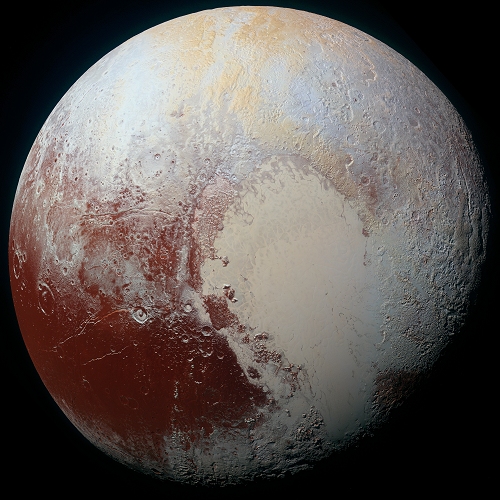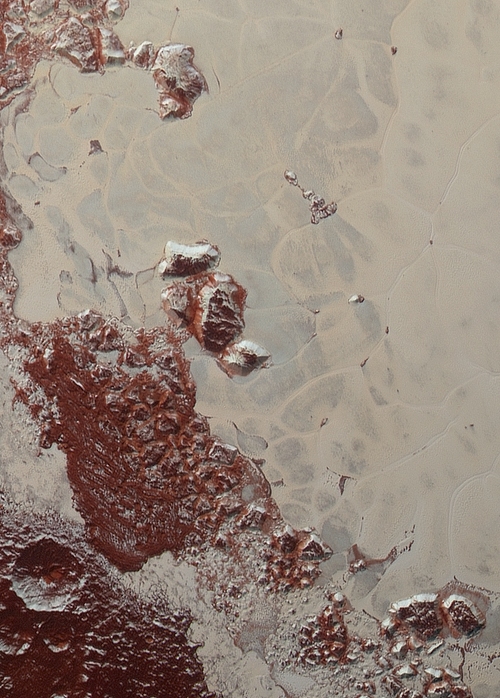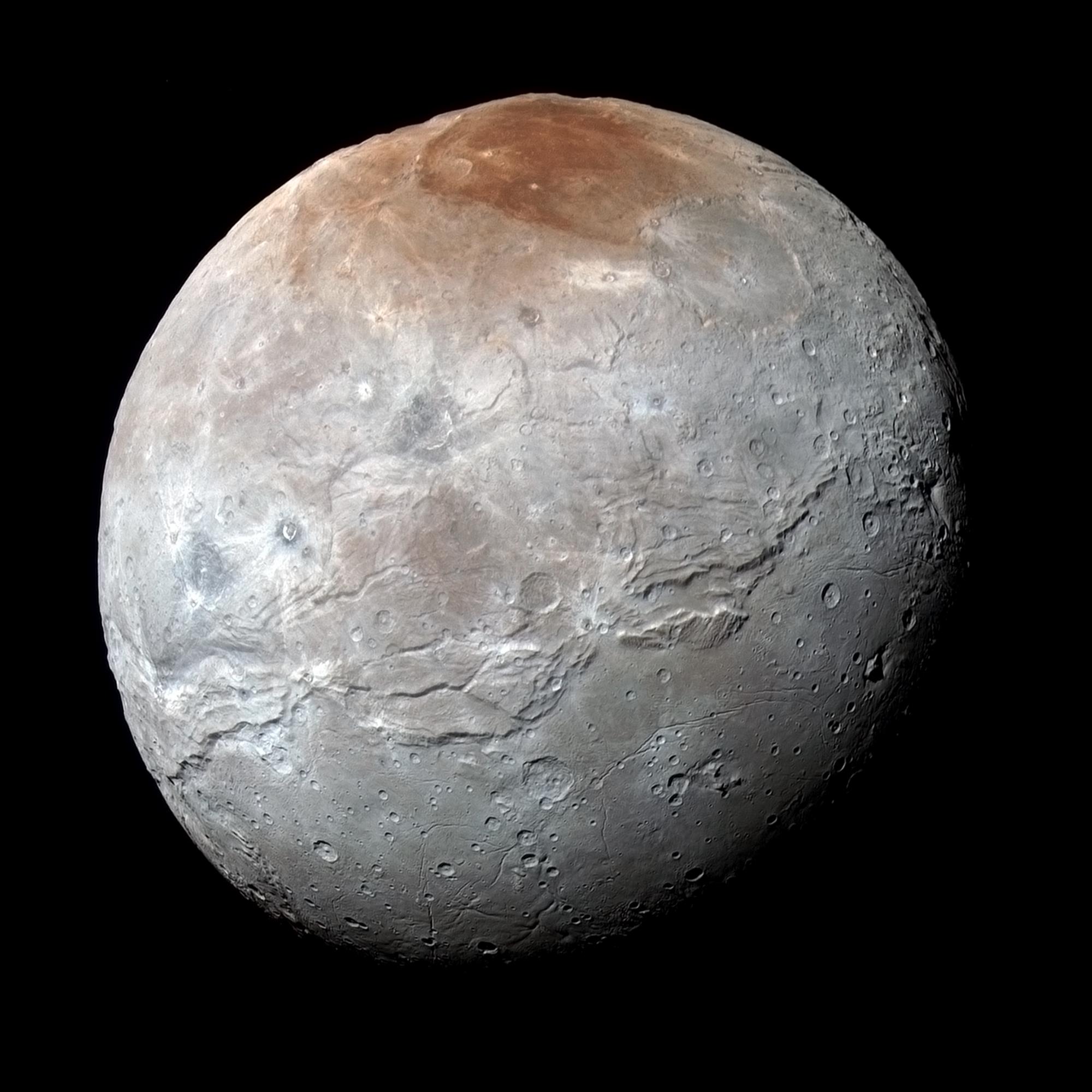It looks like you're using an Ad Blocker.
Please white-list or disable AboveTopSecret.com in your ad-blocking tool.
Thank you.
Some features of ATS will be disabled while you continue to use an ad-blocker.
share:
Posting this image for everyone's appreciation:

Detail (at 50% scale)

Strange that ATS hasn't exploded with the buzz over this image yet.
www.nasa.gov...

Detail (at 50% scale)

Strange that ATS hasn't exploded with the buzz over this image yet.
www.nasa.gov...
NASA’s New Horizons spacecraft captured this high-resolution enhanced color view of Pluto on July 14, 2015. The image combines blue, red and infrared images taken by the Ralph/Multispectral Visual Imaging Camera (MVIC). Pluto’s surface sports a remarkable range of subtle colors, enhanced in this view to a rainbow of pale blues, yellows, oranges, and deep reds. Many landforms have their own distinct colors, telling a complex geological and climatological story that scientists have only just begun to decode. The image resolves details and colors on scales as small as 0.8 miles (1.3 kilometers). The viewer is encouraged to zoom in on the full resolution image on a larger screen to fully appreciate the complexity of Pluto’s surface features.
originally posted by: xoenneox
Holy, it's 67mb image, damn!
I've uploaded the image to Gigapan for easier viewing and exploration.
www.gigapan.com...
As well as giving us that fantastic and very detailed (enhanced) colour view of Pluto, the Ralph/MVIC camera gave us this great view of Pluto's moon
Charon: www.nasa.gov...


NASA's New Horizons captured this high-resolution enhanced color view of Charon just before closest approach on July 14, 2015. The image combines blue, red and infrared images taken by the spacecraft’s Ralph/Multispectral Visual Imaging Camera (MVIC); the colors are processed to best highlight the variation of surface properties across Charon. Charon’s color palette is not as diverse as Pluto’s; most striking is the reddish north (top) polar region, informally named Mordor Macula. Charon is 754 miles (1,214 kilometers) across; this image resolves details as small as 1.8 miles (2.9 kilometers).
Credits: NASA/JHUAPL/SwRI
originally posted by: eriktheawful
a reply to: wildespace
Hmmmmmm.....(cool pic btw!)
I wonder what all that material up there is?
The material is mostly forzen gasses like methane and nitrogen, with some mineral dust. The outer Solar System (including Pluto and its moons) is very icy, in contast to the rocky/metallic composition of Earth and other terrestrial planets.
a reply to: wildespace
Oh I know it's more than likely frozen gases, was just wondering what would be giving it that red/brown look. I'm thinking it might be a mixture of minerals of some sort, from down inside Charon, considering it looks like an ancient impact area.
Oh I know it's more than likely frozen gases, was just wondering what would be giving it that red/brown look. I'm thinking it might be a mixture of minerals of some sort, from down inside Charon, considering it looks like an ancient impact area.
originally posted by: eriktheawful
a reply to: wildespace
Oh I know it's more than likely frozen gases, was just wondering what would be giving it that red/brown look. I'm thinking it might be a mixture of minerals of some sort, from down inside Charon, considering it looks like an ancient impact area.
The red-ish colouring is from tholins, complex hydrocarbons that formed under the solar and cosmic radiation.
new topics
-
Stuck Farmer And His Queue Jumping Spawn
Rant: 5 minutes ago -
Paradox of Progress
Ancient & Lost Civilizations: 8 hours ago -
Joe Biden gives the USA's Highest Civilian Honor Award to Hillary Clinton and George Soros.
US Political Madness: 10 hours ago -
Winter Storm
Fragile Earth: 11 hours ago
top topics
-
Joe Biden gives the USA's Highest Civilian Honor Award to Hillary Clinton and George Soros.
US Political Madness: 10 hours ago, 13 flags -
What Is 'Quad Demic'? Mask Mandate Returns In These US States
Diseases and Pandemics: 17 hours ago, 11 flags -
Winter Storm
Fragile Earth: 11 hours ago, 7 flags -
Paradox of Progress
Ancient & Lost Civilizations: 8 hours ago, 6 flags -
A great artist and storyteller, for kids of all ages
General Entertainment: 13 hours ago, 5 flags -
Biden Face Planted Somewhere
Politicians & People: 13 hours ago, 5 flags -
Stuck Farmer And His Queue Jumping Spawn
Rant: 5 minutes ago, 0 flags
active topics
-
Stuck Farmer And His Queue Jumping Spawn
Rant • 0 • : TimBurr -
The Future of fashion .
Social Issues and Civil Unrest • 20 • : Flyingclaydisk -
NJ Drones tied to Tesla explosion at Trump Las vegas
General Conspiracies • 46 • : Flyingclaydisk -
Tesla Cybertruck Explodes in Front of Trump Hotel in Las Vegas
Mainstream News • 222 • : Flyingclaydisk -
The Why Files Lacerta Reveals the Truth of our Creation
Aliens and UFOs • 13 • : Lazy88 -
What Is 'Quad Demic'? Mask Mandate Returns In These US States
Diseases and Pandemics • 30 • : butcherguy -
Winter Storm
Fragile Earth • 19 • : RazorV66 -
Post A Funny (T&C Friendly) Pic Part IV: The LOL awakens!
General Chit Chat • 7988 • : KrustyKrab -
Paradox of Progress
Ancient & Lost Civilizations • 3 • : BingoMcGoof -
Here we again... CHINA having mass outbreak of something
Diseases and Pandemics • 24 • : NoCorruptionAllowed
